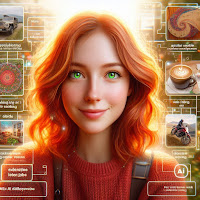AI as a Mirror: Reflecting on our self-identity through AI
Crafting the image of “me”
 |
| Figure 1. |
This process got me thinking about how we define identity online. Maybe it’s not just about how we look, but how we express and feel about who we are.
Song: California from Run Devil Run.
Does AI do a better job of representing you than you?
 |
| Figure 2. |
In contrast, my real selfie (Figure 2) looked quite different. It was more serious and reserved, while the AI version projected warmth and expression. The AI-generated image seemed to resonate more with how I perceive myself. The ability to provide details in the prompt allowed the AI to incorporate elements of my personality. This is often difficult to convey in traditional selfies. This moment echoed the research by Moga and Rughiniş (2023), who suggest that AI-generated images can reveal aspects of identity that are tough to express through conventional photos.
AI's Identity Crisis: the problem of AI reducing identities into stereotypes
 |
| Figure 3. |
 |
| Figure 4. |
 |
| Figure 5. |
From Course to Conversation: Translating Academic Jargon into Reader-Friendly Content
When I began turning my academic critique into a blog post, I quickly realized I had to rethink how I wanted to communicate. Academic writing is often dense and fact-focused. A blog, on the other hand, invites the reader into a conversation. It’s not just about sharing ideas, but about making them resonate with a broader audience.
This shift in format reminded me of Manovich’s (2001) ideas on new media, where content lives in a global, participatory space. Blogging meant stepping into that space. It also connected with the concept of transliteracy, which Thomas (2013) describes as the ability to navigate across platforms and engage diverse audiences. That meant adjusting not only the tone and language but also the structure and feel of the content.
To do this, I broke down complex theories into accessible
ideas, cut out jargon, and added visuals that might improve understanding. But
more importantly, I made it personal. Including my own experiences helped the
post feel more relatable, opening a space for connection. This ties into the
idea of the gift economy, where shared knowledge (Stevenson, 2018) creates
community rather than just delivering content. Embracing transliteracy helped
me move from academic texts into a more open, conversational space where
critical reflection becomes a shared experience.
References
Gautam, S.,
& Ghosh, S. (2024, October 7). Non-Western cultures misrepresented, harmed
by
Generative
AI, researchers say. Penn State College of Information Sciences and
Technology. https://ist.psu.edu/about/news/venkit-aies-social-harms
Ho, S. C. Y.
(2023). From Development to Dissemination: Social and Ethical Issues with
Text-to-Image
AI-Generated Art. Proceedings of the Canadian Conference on
Artificial
Intelligence. https://doi.org/10.21428/594757db.acad9d77
Manovich, L. (2001). What is new media? In: The language
of new media. MIT Press.
https://dss-edit.com/plu/Manovich-Lev_The_Language_of_the_New_Media.pdf
Miltner, K.
(2024). Lensa and the discourse of visual generative AI. University of
Sheffield.
https://doi.org/10.33621/jdsr.v6i440456
Moga, D. A.,
& Rughiniş, C. (2023). Idealized self-presentation through AI avatars. A
case
study
of Lensa AI. In 2023 24th International Conference on Control Systems
and
Computer
Science (CSCS) (pp. 426-430). IEEE. https://www.researchgate.net/profile/Cosima-Rughinis/publication/371006582_Idealized_Self-Presentation_through_AI_Avatars_A_Case_Study_of_Lensa_AI/links/646e830f37d6625c002e469f/Idealized-Self-Presentation-through-Al-Avatars-A-Case-Study-of-Lensa-Al.pdf
Mohamed, Y.A.,
Mohamed, A.H., Kannan, A., Bashir, M., Adiel, M.A., & Elsadig, M.A.
(2024).
Navigating the Ethical Terrain of AI-Generated Text Tools: A Review. IEEE
Access,
12, 197061-197120.
Nicoletti, L.
& Bass, D. (June 9, 2023). Humans Are Biased. Generative AI Is Even Worse.
Bloomberg.
https://www.bloomberg.com/graphics/2023-generative-ai-bias/
Stevenson, M. (2018), "From Hypertext to Hype and Back
Again: Exploring the Roots of
Social Media in the Early Web.”
Retrieved from https://hcommons.org/deposits/item/hc:16611/
Thomas, S. (2013, March 15). TRANSLITERATE SPACES [PowerPoint slides].
eClass.
https://eclass.srv.ualberta.ca/mod/resource/view.php?id=8288118

Comments
Post a Comment